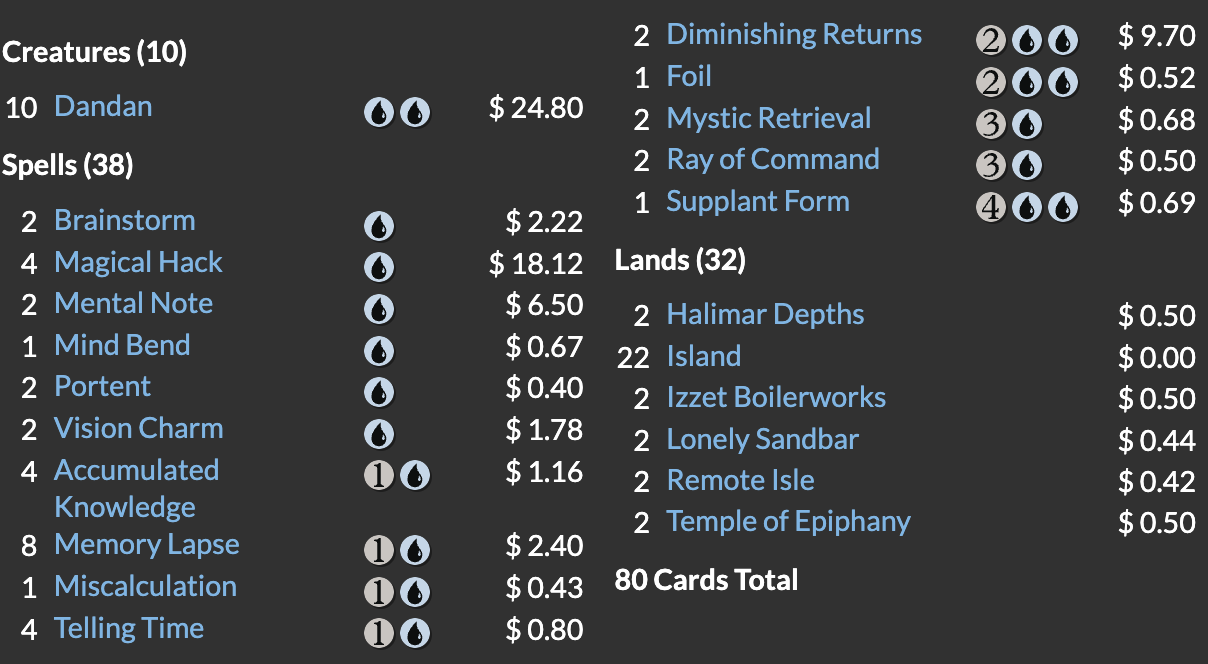Loading...
Products
Magic: The Gathering Line
Let's start by defining what the format is. The name Dandân comes from the card Dandân, which is a formidable 4/1. The format is also known sometimes as Forgetful Fish.
There are a lot of different variants, but let me lay out the general premise:
You play 1 on 1
You share one library
You share one graveyard
There are 80 cards in the shared library
Every card is a two-of with a couple of exceptions
There are 10 Dandâns
There are 8 Memory Lapses
The number of basic Islands is unrestricted
I know that's a lot, so let me show you an example decklist, so you can properly visualise it.
You can find it here.

Let's discuss the implications of the deck building rules, as it does directly affect how the games play out.
It's a on 1 on 1 format which has inherently different dynamics to multi-player. You're the only person in charge of battling your opponent and no third party will change what's happening.
Sharing the same library is the most interesting and important part of the format. The deck is full of traditionally blue effects that manipulate the top of the library, such as Brainstorm, Portent, and the 8-copy special in Memory Lapse. Some people lean into this aspect even more and really overload on such effects, adding all the Ponders, Preordains, and Serum Visions of the world.
As you share the library, the card you leave on top when passing the turn is going to be drawn by the opponent. This is a much bigger deal in practice than it might sound. Every Brainstorm you resolve forces you to remember the two cards put back, their order, who will draw what and then correct that whenever a draw spell is played. Opponent senses you're missing lands? They can set up the top appropriately. They might play their Brainstorm and put two nonlands on top, etc. It's a very interesting dynamic that needs to be *felt* in practice.
Sharing the graveyard matters if your version of the deck has graveyard synergies. Have that in mind when assembling your own deck!
Two-ofs make it so that there is a bit of diversity in gameplay. You can naturally tweak it to your prefence and make some cards 3-ofs or even the whole deck singleton - remember that it's like a personal blue out-of-the-box cube.
10 Dandâns has been the standard number that hits the sweet spot between never being really creature flooded but also being able to close games. When creating your version, make sure to strike the balance between the total number of Dandâns and the total number of actual removal. If you make the second number much greater, games will just not end.
8 Lapses lean into the shared library dynamic. Counterspell would be significantly more boring here. Any number of basics is a pretty common rule in most formats, so no surprise it's also here.
As I've previously alluded to, this format/deck is an out-of-the-box full Magic experience for two people. I think it's important to stress it, as it means you can always take a deckbox with you and play between the rounds or late night while drinking tea. You don't need anyone to be prepped - you bring the deck, you can play; as simple as that.
On top of that, the gameplay is really stimulating. You have to juggle your land drops, card advantage, order of cards in the library, threats and life total. It's truly a ton of fun. But fair warning - after a couple of games it does get tiring due to the sheer amount of decisions you have to keep making per turn.
Moreover, it's a fully customizable experience. There is no ban list, stock list, hard rules. Everything I laid out above are conventions but still - conventions held by a small (but dedicated!) group of players. Therefore, you can feel free to change it up to your preference! It'd say more - you're actively encouraged to explore that space to make it your own. I myself created an 'all old frame' version. I've seen people play more creatures, I have even come across other color motiffs entirely such as BG lands. They naturally don't include the card Dandân, but they are in the spirit of the format.
Another great aspect is the price. You can get it assembled pretty cheap, especially if you swap out some pricier cards. Dandâns themselves will cost you around 50 Cent to 2 Euro a piece but that's the biggest cost. If you get some *played* Dandâns, you'll save on the cost and get that old-school feel as well!
Affordable? Check!
Ready out-of-the-box? Check!
Interesting gameplay? Check!
Allows for customisation? Check!
If you're still considering whether to give Dandân a go, watch how it plays out on YouTube for instance here and you'll be convinced in no time. I can tell you though that nothing shows its vibes like playing it yourself, in person, in paper.